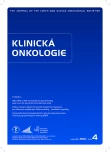Bortezomib in Multiple Myeloma Patients after Allogeneic Stem Cell Transplantation
Authors:
S. Vokurka
Authors‘ workplace:
Hematologicko‑onkologické oddělení FN Plzeň
Published in:
Klin Onkol 2010; 23(4): 242-244
Category:
Reviews
Overview
Bortezomib represents a novel biological and targeted treatment modality with excellent treatment results in multiple myeloma patients. Bortezomib has also been successfully used several times in heavily pre‑treated patients with myeloma relapse or progression after allogeneic stem cell transplantation. Its immunomodulatory effect, mediated, for instance, through the selective apoptosis of alloreactive T‑lymphocytes and inhibition of the nuclear factor kappa B, brings the potential of graft versus host disease management, while the immunological anti‑tumour effect remains preserved. Apart from thrombocytopenia, neurotoxicity most likely potentiated by concomitant and long‑term use of cyclosporine is the major side effect of the treatment. The impact and modulation of graft versus host disease remains controversial in clinical practice. Bortezomib is effective and feasible in the post‑transplant setting.
Key words:
multiple myeloma – bortezomib – allogeneic transplantation – hematopoietic stem cell transplantation
Sources
1. Drobyski W, Vodanovic‑ Jankovic S, Hari P et al. Targeting NF‑ Kß for the Prevention of Graft Versus Host Disease. Blood 2005; 106: 3109– 3109.
2. Sun K, Welniak L, Panoskaltsis‑ Mortari A et al. Inhibition of acute graft‑ versus‑ host disease with retention of graft‑ versus‑ tumor effects by the proteasome inhibitor bortezomib. PNAS 2004; 101(21): 8120– 8125.
3. Blanco B, Pérez‑ Simón J, Sánchez‑ Abarca L et al. Bortezomib induces selective depletion of alloreactive T lymphocytes and decreases the production of Th1 cytokines. Blood 2006; 107(9): 3575– 3583.
4. Blanco B, Perez‑ Simon J, Sanchez‑ Abarca L et al. Treatment with bortezomib of human CD4+ T cells preserves natural regulatory T cells and allows the emergence of a distinct suppressor T‑ cell population. Haematologica 2009; 94(7): 975– 983.
5. Shi J, Trikot G, Garg T et al. Bortezomib down‑ regulates the cell‑ surface expression of HLA class I and enhances natural killer cell‑ mediated lysis of myeloma. Blood 2008; 111(3): 1309– 1317.
6. Wang X, Ottosson A, Ji C et al. Proteasome inhibition induces apoptosis in primary human natural killer cells and suppresses NKp46– mediated cytotoxicity. Haematologica 2009; 94(4): 470– 478.
7. Spisek R, Charalambous A, Mazumder A et al. Bortezomib enhances dendritic cell (DC)‑ mediated induction of immunity to human myeloma via exposure of cell surface heat shock protein 90 on dying tumor cells: therapeutic implications. Blood 2007; 109(11): 4839– 4845.
8. El‑ Cheikh J, Michallet M, Nagler A et al. High response rate and improved graft‑ versus‑ host disease following bortezomib as salvage therapy after reduced intensity conditioning allogeneic stem cell transplantation for multiple myeloma. Haematologica 2008; 93(3): 455– 458.
9. Bruno B, Patriarca F, Sorasio R et al. Bortezomib with or without dexamethasone in relapsed multiple myeloma following allogeneic hematopoietic cell transplantation. Haematologica 2006; 91(6): 837– 839.
10. Kroger N, Zabelina T, Ayuk F et al. Bortezomib after dose‑reduced allogeneic stem cell transplantation for multiple myeloma to enhance or maintain remission status. Exp Hematol 2006; 34(6): 770– 775.
11. Mateos‑ Mazon J, Pérez‑ Simón JA, Polez O et al. Use of bortezomib in the management of chronic graft‑ versus‑ host disease among multiple myeloma patients relapsing after allogeneic transplantation. Haematologica 2007; 92(9): 1295– 1296.
12. Giaccone L, Sorasio R, Patriarca F et al. Bortezomib after allografting in multiple myeloma: association between neurotoxicity and cyclosporine treatment. Biol Blood Marrow Transplant 2007; 13(4): 497– 499.
13. van de Donk N, Kröger N, Hegenbart U et al. Remarkable activity of novel agents bortezomib and thalidomide in patients not responding to donor lymphocyte infusions following nonmyeloablative allogeneic stem cell transplantation in multiple myeloma. Blood 2006; 107: 3415– 3416.
14. Špička I, Hájek R, Vytrasová M et al. Bortezomib (Velcade) in relapsed/ refractory multiple myeloma – the first experience in the Czech Republic. Cas Lek Cesk 2005; 144: 638– 640.
15. Hajek R, Zahradova L, Gregora E et al. The Reduced Intensity Cvd Regimen: A Good Option with Well Balanced Efficacy/ Toxicity Ratio for Elderly Patients with Poor Status Performance. Blood 2008; 112: 1267.
Labels
Paediatric clinical oncology Surgery Clinical oncologyArticle was published in
Clinical Oncology

2010 Issue 4
Most read in this issue
- Merkel Cell Skin Carcinoma
- Metastatic Breast Cancer in 28 Years Old Man
- Bile Duct Malignancies
- Targeted Therapy with an EGFR Tyrosine Kinase Inhibitor in Bronchioloalveolar Carcinoma of the Lung: A Literature Review and a Case Study of Clinically Prompt and Intensive Response to Erlotinib.
